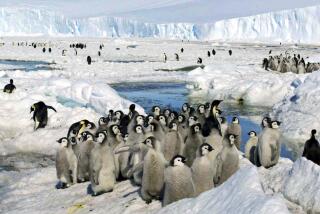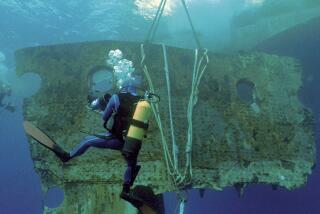Guidelines Drawn for Antarctica
- Share via
Many people view Antarctica as the most isolated and desolate area on Earth. It might surprise them, therefore, that during the most recent tourist season--December, 1988 through February, 1989--nearly 3,000 visitors traveled there, most of them by ship.
Some 2,500 travelers are expected to visit during the 1989-90 season, the reduced number being due to the scheduling of fewer tours.
One of the five passenger-carrying vessels operating last season, the Argentine supply ship Bahia Paraiso ran aground in January, spilling 500 to 600 metric tons of diesel fuel near Palmer Station.
All 316 passengers and crew aboard were rescued by other vessels and, after the remaining barrels of oil and gasoline were off-loaded, the damaged ship was towed away.
In the wake of the spill, National Science Foundation officials based in Antarctica found dead penguins, cormorants and skuas--sea gull-like predators who feed on baby penguins and penguin eggs.
While limpets, sponges and kelp also were damaged, life at the bottom of the sea was apparently spared, because the fuel stayed close to the surface of the water.
Yet there still are no international regulations governing what types of ships can visit Antarctica, how many passengers and crew can be aboard, what kind of ice navigation training ship crews should have and what sort of ice protection is needed on ship hulls.
In the absence of formal regulations, three expedition companies operating ships in Antarctica during the 1989-90 season have compiled a set of environmental guidelines.
Drawn up jointly by Werner Zehnder of Society Expeditions in Seattle, Leo LeBon of Mountain Travel in El Cerrito, Calif., and Darrel Schoeing of New York-based Travel Dynamics, the guidelines will be presented along with a briefing on Antarctic conservation to all passengers boarding expedition vessels.
Visitors are cautioned to stay at least 15 feet from penguins and crawling seals and 50 feet from fur seals. They are told to remain quiet at all times, never touch the wildlife, avoid damaging the fragile plant life and return all litter to the vessel. No food is to be taken ashore, and items from shore such as rocks, shells and bones may not be removed.
In addition, the Antarctic Conservation Act of 1978 makes it illegal to take any native flora or fauna or to introduce any species of plant or animal life in to the environment.
How much and what kind of tourism is too much for the Antarctic?
Zehnder, senior vice president of planning and operations for Society Expeditions and an Antarctic travel veteran, is opposed to helicopter tourist flights, mountain climbing, cross-country skiing and camping in the Antarctic, all of them the kind of expeditions undertaken by one company or another.
He detailed his reasons in an address delivered in New York last month at the forum, “Antarctica: Continent at Risk,” sponsored by the Tinker Foundation, a private group that focuses on the Antarctic, Latin America and Iberia.
“I have observed hundreds of penguins leaving their nests when supply helicopters flew over their rookeries. Following the helicopters were skuas--who are much smarter than the penguins and have adapted to the helicopters--and they had feasts on the abandoned penguin eggs and small chicks . . . One helicopter can do more damage than 5,000 controlled and supervised visitors.”
Land-based activities, he added, put unnecessary pressure on rescue parties and other scientific organizations that have barely enough time to keep up with project work during the brief Antarctic summer.
But Zehnder also believes that small, self-contained expedition ships do not leave environmental hazards behind, and are capable of landing passengers in varying areas to be sure that no one site is over-visited.
Ships scheduled to visit the Antarctic this season are Society Expeditions’ 139-passenger World Discoverer and 96-passenger Society Explorer, Travel Dynamics’ 136-passenger Illiria and Mountain Travel’s 39-passenger ship Nordbrise. All but the Illiria have hardened hulls to resist ice.
Even at an average price of about $350 per person per day, the sailings sell out quickly. Thus, to be assured of a place, most passengers book six months to a year ahead.
Still more traffic is in store for Antarctica in 1991, when a new 164-passenger expedition ship under construction in Japan will visit.
The Frontier Spirit, a joint venture of Salen Lindblad Cruising, Japan’s NYK Line, Mitsubishi and Hapag-Lloyd, will carry a Super Ice Class rating, higher than any of the vessels sailing there now, as well as on-board sewage treatment plants, refrigerated garbage storage and special storage areas for non-biodegradable waste.
More to Read
Sign up for The Wild
We’ll help you find the best places to hike, bike and run, as well as the perfect silent spots for meditation and yoga.
You may occasionally receive promotional content from the Los Angeles Times.






